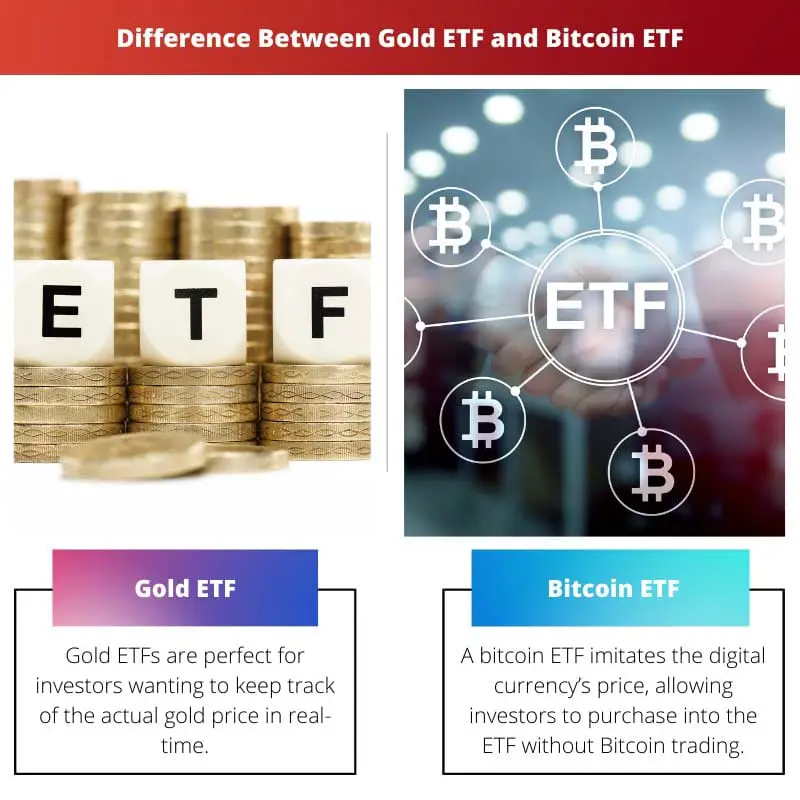Gold ETFs track the price of physical gold, offering investors exposure to the precious metal without direct ownership. Bitcoin ETFs, on the other hand, mirror the performance of Bitcoin, a decentralized digital currency. While gold is a traditional store of value with a long history, Bitcoin is a relatively newer asset class with unique characteristics, including digital scarcity and decentralization, making the choice between the two dependent on investor preferences and risk appetite.
Key Takeaways
- Gold ETF invests in physical gold, while Bitcoin ETF invests in cryptocurrency.
- Gold ETF is considered a more stable and traditional investment, while Bitcoin ETF is considered a high-risk, high-reward investment.
- Gold ETF is regulated by government agencies and subject to financial regulations, while Bitcoin ETF is largely unregulated and subject to price fluctuations.
Gold ETF vs Bitcoin ETF
The difference between gold ETF and bitcoin ETC is that gold ETF is a commodity-based mutual fund that invests in assets such as gold. Exchange-Traded Fund. These foreign currency funds operate like equities and are exchanged on the stock exchange in the same way. Bitcoin ETFs are exchange-traded funds that monitor the value of Bitcoin and trade on standard markets instead. They allow investors to invest in Bitcoin without the inconvenience of exchanging crypto-monetary money while leveraging its price.

Gold ETF is a commodity-based mutual fund investing in such assets. Exchange-Traded Fund. These foreign currency funds operate like equities and are exchanged on the stock exchange in the same way.
A Bitcoin ETF would function the same, with a one-size-fits-all share pricing fluctuating in the exchange-traded fund. If bitcoin climbs, the ETF climbs, and the other way around.
Comparison Table
| Feature | Gold ETF | Bitcoin ETF |
|---|---|---|
| Underlying Asset | Physical Gold | Bitcoin (digital currency) |
| Investment Type | Established, tangible asset | New, intangible asset |
| Volatility | Relatively Low | High |
| Returns (Historical) | Generally modest and steady | Potentially high with significant fluctuations |
| Expense Ratio | Typically around 0.4% | May be slightly lower than Gold ETFs (around 0.33%) |
| Regulation | Well-established regulations | Newer asset class with evolving regulations |
| Liquidity | Highly liquid, traded on major stock exchanges | Highly liquid, but can be less liquid than Gold ETFs on some exchanges |
| Safety | Considered a safe-haven asset | Riskier due to the volatility of Bitcoin |
What is Gold ETF?
Gold Exchange-Traded Funds (Gold ETFs) are financial instruments that provide investors with a convenient and cost-effective way to invest in gold. These investment vehicles are designed to track the performance of the price of gold, allowing investors to gain exposure to the precious metal without physically owning it.
Structure and Operation
1. Creation and Redemption
Gold ETFs are structured as open-ended investment funds, meaning they can issue and redeem shares based on investor demand. Authorized Participants (APs), typically large financial institutions, play a crucial role in the creation and redemption process. When an investor buys shares, the ETF issues new shares, and when an investor sells, the ETF redeems the shares.
2. Benchmark Index
Most Gold ETFs aim to replicate the performance of a specific benchmark index, which is usually a gold price index. The ETF’s goal is to closely track the movements in the price of gold, providing investors with a return that mirrors the precious metal’s performance.
Advantages of Gold ETFs
1. Liquidity
Gold ETFs are traded on stock exchanges, providing investors with high liquidity. They can buy or sell shares throughout the trading day at market prices, making it easy to enter or exit positions.
2. Cost-Efficiency
Investing in physical gold often involves additional costs such as storage and insurance. Gold ETFs eliminate these costs, making them a more cost-efficient option for investors seeking exposure to gold.
3. Accessibility
Gold ETFs offer retail investors easy access to the gold market. Investors can buy and sell shares through their brokerage accounts, providing a straightforward investment option compared to purchasing and storing physical gold.
Risks and Considerations
1. Market Risks
Like any investment, Gold ETFs are subject to market risks. Fluctuations in the price of gold can impact the value of the ETF. Additionally, factors such as interest rates, currency movements, and geopolitical events can influence gold prices.
2. Tracking Error
While Gold ETFs aim to replicate the performance of a specific index, there may be slight discrepancies known as tracking errors. These errors can result from factors such as fees, expenses, and the mechanics of the creation and redemption process.
Tax Implications
1. Capital Gains
Investors in Gold ETFs may be subject to capital gains taxes when they sell their shares for a profit. The tax treatment depends on factors such as the investor’s holding period and tax jurisdiction.
2. Dividends
Some Gold ETFs may distribute dividends to investors, which could have tax implications. Investors should be aware of the tax treatment of these distributions in their respective jurisdictions.

What is Bitcoin ETF?
A Bitcoin Exchange-Traded Fund (ETF) is a financial product designed to provide investors with exposure to Bitcoin, the popular cryptocurrency. Unlike traditional investments in Bitcoin, which involve buying and storing the digital currency directly, a Bitcoin ETF allows investors to gain exposure to the price movements of Bitcoin without actually owning the cryptocurrency.
Structure of a Bitcoin ETF
Custody
One of the critical components of a Bitcoin ETF is custody. The ETF holds the actual Bitcoin on behalf of the investors. Custody solutions vary among ETF providers and can include cold storage, hot wallets, or a combination of both to ensure the security of the digital assets.
Creation and Redemption Mechanism
Bitcoin ETFs typically operate on a creation and redemption mechanism. Authorized Participants (APs) are responsible for creating or redeeming shares of the ETF based on demand. When creating new shares, APs deposit the required amount of Bitcoin with the ETF, and in the case of redemptions, they receive the equivalent amount of Bitcoin.
Net Asset Value (NAV)
The Net Asset Value of a Bitcoin ETF is the total value of its assets minus liabilities, divided by the number of outstanding shares. It represents the per-share value of the ETF and is crucial for investors to gauge its performance relative to the Bitcoin market.
Advantages of Bitcoin ETFs
Accessibility
Bitcoin ETFs provide a convenient and accessible way for traditional investors to gain exposure to Bitcoin without dealing with the complexities of cryptocurrency exchanges and wallets.
Liquidity
Being listed on stock exchanges, Bitcoin ETFs offer liquidity, allowing investors to buy and sell shares throughout the trading day at market prices. This liquidity is especially beneficial for institutional investors.
Regulatory Oversight
Bitcoin ETFs are subject to regulatory oversight, providing investors with a level of security and compliance that may be lacking in the unregulated cryptocurrency markets.
Challenges and Risks
Market Volatility
The value of Bitcoin is highly volatile, and as a result, Bitcoin ETFs can experience significant price fluctuations. Investors should be aware of the risks associated with the inherent volatility of the cryptocurrency market.
Regulatory Uncertainty
Regulatory approval and compliance are critical factors for the success of a Bitcoin ETF. Changes in regulations or uncertainties surrounding regulatory decisions can impact the ETF’s operation and market perception.
Security Concerns
While custody solutions aim to secure the digital assets held by the ETF, the cryptocurrency space is susceptible to hacking and security breaches. Investors must consider the robustness of the ETF’s security measures.

Main Differences Between Gold ETF and Bitcoin ETF
- Underlying Asset:
- Gold ETFs track the price of physical gold. Each unit of the ETF is typically backed by a certain amount of gold held in a vault.
- Bitcoin ETFs track the price of Bitcoin, a digital cryptocurrency. Instead of physical holdings, the ETF holds Bitcoin as the underlying asset.
- Nature of Asset:
- Gold is a physical commodity with tangible value and has been used as a store of value for centuries.
- Bitcoin is a digital currency and a relatively new asset class. It operates on blockchain technology and is decentralized.
- Storage and Security:
- Gold ETFs require secure storage facilities for the physical gold, incurring costs for vaults and security measures.
- Bitcoin ETFs store digital assets in digital wallets and require cybersecurity measures to protect against hacking and unauthorized access.
- Market Hours and Accessibility:
- Gold ETFs are traded on traditional stock exchanges and follow regular market hours.
- Bitcoin ETFs, being related to cryptocurrency, can be traded 24/7 on cryptocurrency exchanges, providing continuous accessibility.
- Volatility:
- Gold generally has lower price volatility compared to Bitcoin, which is known for its price fluctuations.
- Regulation:
- Gold ETFs are subject to regulations governing commodity trading and investment funds.
- Bitcoin ETFs may face additional regulatory challenges and scrutiny due to the evolving nature of cryptocurrency regulations.
- Historical Significance:
- Gold has a long history as a traditional safe-haven asset and a hedge against inflation.
- Bitcoin is a relatively recent innovation and is often considered a more speculative and volatile investment.
- Dividends and Yields:
- Some Gold ETFs may distribute dividends based on the income generated from physical gold holdings.
- Bitcoin ETFs typically do not provide dividends; instead, returns come from changes in the price of Bitcoin.
- Custodianship:
- Gold ETFs involve custodians responsible for the physical storage and safekeeping of gold.
- Bitcoin ETFs also have custodians but for digital wallets and private keys securing access to the Bitcoin holdings.
- Acceptance and Recognition:
- Gold has universal recognition as a precious metal and is widely accepted as a store of value.
- Bitcoin’s acceptance is still evolving, with varying degrees of recognition and acceptance in different jurisdictions and industries.

- https://www.sciencedirect.com/science/article/pii/S1544612318305695
- https://www.tandfonline.com/doi/abs/10.1080/13504851.2017.1340564